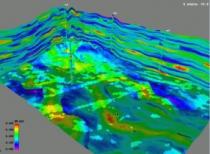PETROSIM - Simulation of petrophysical parameters
PETROSIM - Simulation of petrophysical parameters
In order to predict the production of a petroleum reservoir it is important to derive good mathematical models for the geology of the reservoir. The petrophysical parameters, i.e. permeability, porosity and saturations, will affect the flow of the oil, water and gas present in the reservoir, and it is therefore important to generate realistic models of these.
Petrophysical parameters
The petroleum industry continuously requires improved software as the amount of data that should be included in the simulated realizations of the petrophysical parameters grows. NR developed a similar module one decade ago, and compared to that, the new module uses less memory, runs considerably faster, and has a lot of new functionality. Today, is should be possible to use the module on petroleum reservoirs that have thousands of well data that must be fully honored in the simulated realizations. In addition there are seismic data that has information about the reservoir at a much coarser resolution than the well data.

A fluvial reservoir with porosity simulated with PETROSIM. The trends follow the shape of the objects, and also show a different behavior at different relative depths and positions.
The figure shows the most important, and petroleum containing, parts of a so-called fluvial reservoir. Here the reservoir primarily consists of river-like objects consisting of sandstone made from gravel and sand deposits from rivers. In such reservoirs there are a gradual change of the petrophysical properties within these objects. The coloring in figure demonstrates that the porosity changes both laterally and vertically, in accordance with the geological processes that lead to these deposits. A best possible reservoir model is important to be able to give reliable predictions about future productions. It is therefore important to develop reservoir models that incorporate actual geological phenomena.


Co-simulation of porosity (right) based on a seismic impedance cube (left). The seismic grid has a much coarser resolution than the porosity grid, but the main features are kept.

Contact information
Financing
Roxar Software Services


 How to get to NR
How to get to NR Share on social media
Share on social media Privacy policy
Privacy policy